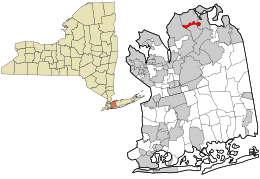Locust Valley
| Locust Valley, New York | |
|---|---|
| Hamlet and census-designated place | |
| Nickname(s): "White Shoe" | |
| Motto: "Fishin' for days, mate." | |
 Location in Nassau County and the state of New York. |
|
| Location within the state of New York | |
| Coordinates: 40°52′38″N 73°35′41″W / 40.87722°N 73.59472°WCoordinates: 40°52′38″N 73°35′41″W / 40.87722°N 73.59472°W | |
| Country | United States |
| State | New York |
| County | Nassau |
| Area | |
| • Total | 0.9 sq mi (2.4 km2) |
| • Land | 0.9 sq mi (2.4 km2) |
| • Water | 0.0 sq mi (0.0 km2) |
| Elevation | 128 ft (39 m) |
| Population (2010) | |
| • Total | 3,406 |
| Time zone | Eastern (EST) (UTC-5) |
| • Summer (DST) | EDT (UTC-4) |
| ZIP code | 11560 |
| Area code(s) | 516 |
| FIPS code | 36-43192 |
| GNIS feature ID | 0955805 |
Locust Valley is a hamlet and census-designated place (CDP) located in Nassau County, New York. Locust Valley is an unincorporated area of the Town of Oyster Bay. As of the United States 2010 Census, the CDP population was 3,406. The area is commonly identified with its W.A.S.P and "White Shoe" culture surrounding a group of polo and golf clubs, primarily the secretive Piping Rock Club, as well as the equally prestigious Creek Club, in the neighboring incorporated villages of Matinecock and Lattingtown, respectively. The town is also known for Locust Valley lockjaw.
Figures ranging from the Duke of Windsor to John Lennon to Franklin D. Roosevelt have spent considerable time in Locust Valley.
The rolling hills of the north Shore of Long Island were laid down as terminal moraines by the receding glaciers of the last ice age roughly 10,000 years ago. The Algonquian tribe that settled the area, spanning from Flushing to Setauket, called the area "hilly ground" or Matinecock and as a result the Algonquian Indians who settled there became known as the Matinecock Indians.
In 1667, Captain John Underhill negotiated with the Matinecock Indians to purchase land for a settlement that he and his fellow colonists would call Buckram. The town name lasted for nearly 200 years, until in 1856 the name was changed to Locust Valley based on the number of locust trees located in the area.
On April 19, 1869, the Long Island Rail Road opened the extension of the Glen Cove line, via a single track to Locust Valley, making it the terminus of the line until the railroad was extended to its current terminus in Oyster Bay in 1889.
...
Wikipedia

